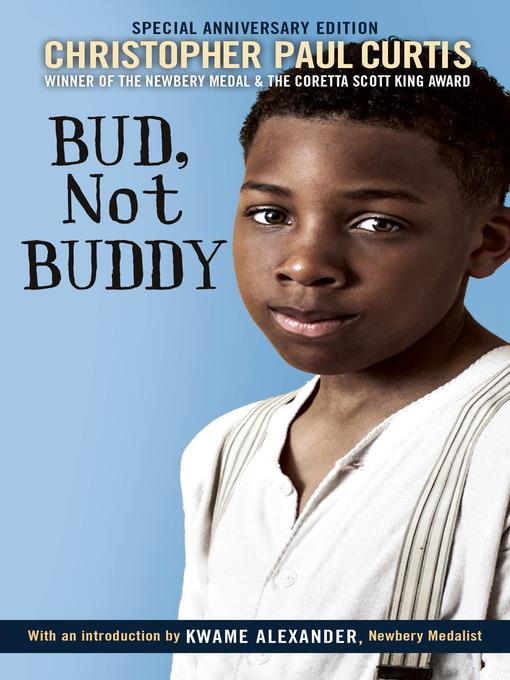
Bud, Not Buddy
(Newbery Medal Winner)
فرمت کتاب
ebook
تاریخ انتشار
2001
Lexile Score
950
Reading Level
3-6
ATOS
5
Interest Level
4-8(MG)
نویسنده
Christopher Paul Curtisشابک
9780385729956
کتاب های مرتبط
- اطلاعات
- نقد و بررسی
- دیدگاه کاربران
نقد و بررسی

jallison - Bud, not Buddy is about the adventure of a boy named Bud as he tries to find his father who he believes is Herman E. Calloway who lives in Grand Rapids. The book is interesting and it made me really care about what happened to Bud. I like how the book uses fictional characters to describe how life would be like during the Great Depression. Bud thinks that his father is Herman because of the pictures his mother left behind when she passed away. I won't spoil the ending, but the ending is really satisfying and hopeful for the future of Bud.

January 7, 2002
A 10-year-old boy in Depression-era Michigan sets out to find the man he believes to be his father. "While the harshness of Bud's circumstances are authentically depicted, Curtis imbues them with an aura of hope, and he makes readers laugh even when he sets up the most daunting scenarios," said PW
in our Best Books citation. Ages 9-12.

September 6, 1999
As in his Newbery Honor-winning debut, The Watsons Go to Birmingham--1963, Curtis draws on a remarkable and disarming mix of comedy and pathos, this time to describe the travails and adventures of a 10-year-old African-American orphan in Depression-era Michigan. Bud is fed up with the cruel treatment he has received at various foster homes, and after being locked up for the night in a shed with a swarm of angry hornets, he decides to run away. His goal: to reach the man he--on the flimsiest of evidence--believes to be his father, jazz musician Herman E. Calloway. Relying on his own ingenuity and good luck, Bud makes it to Grand Rapids, where his "father" owns a club. Calloway, who is much older and grouchier than Bud imagined, is none too thrilled to meet a boy claiming to be his long-lost son. It is the other members of his band--Steady Eddie, Mr. Jimmy, Doug the Thug, Doo-Doo Bug Cross, Dirty Deed Breed and motherly Miss Thomas--who make Bud feel like he has finally arrived home. While the grim conditions of the times and the harshness of Bud's circumstances are authentically depicted, Curtis shines on them an aura of hope and optimism. And even when he sets up a daunting scenario, he makes readers laugh--for example, mopping floors for the rejecting Calloway, Bud pretends the mop is "that underwater boat in the book Momma read to me, Twenty Thousand Leaks Under the Sea." Bud's journey, punctuated by Dickensian twists in plot and enlivened by a host of memorable personalities, will keep readers engrossed from first page to last. Ages 9-12.

December 1, 1999
Gr 4-7-Motherless Bud shares his amusingly astute rules of life as he hits the road to find the jazz musician he believes is his father. A medley of characters brings Depression-era Michigan to life. (Sept.)
Copyright 1999 Library Journal, LLC Used with permission.

Starred review from September 1, 1999
Gr 4-7-When 10-year-old Bud Caldwell runs away from his new foster home, he realizes he has nowhere to go but to search for the father he has never known: a legendary jazz musician advertised on some old posters his deceased mother had kept. A friendly stranger picks him up on the road in the middle of the night and deposits him in Grand Rapids, MI, with Herman E. Calloway and his jazz band, but the man Bud was convinced was his father turns out to be old, cold, and cantankerous. Luckily, the band members are more welcoming; they take him in, put him to work, and begin to teach him to play an instrument. In a Victorian ending, Bud uses the rocks he has treasured from his childhood to prove his surprising relationship with Mr. Calloway. The lively humor contrasts with the grim details of the Depression-era setting and the particular difficulties faced by African Americans at that time. Bud is a plucky, engaging protagonist. Other characters are exaggerations: the good ones (the librarian and Pullman car porter who help him on his journey and the band members who embrace him) are totally open and supportive, while the villainous foster family finds particularly imaginative ways to torture their charge. However, readers will be so caught up in the adventure that they won't mind. Curtis has given a fresh, new look to a traditional orphan-finds-a-home story that would be a crackerjack read-aloud.-Kathleen Isaacs, Edmund Burke School, Washington, DC
Copyright 1999 School Library Journal, LLC Used with permission.

September 1, 1999
Gr. 4^-6. Bud, 10, is on the run from the orphanage and from yet another mean foster family. His mother died when he was 6, and he wants to find his father. Set in Michigan during the Great Depression, this is an Oliver Twist kind of foundling story, but it's told with affectionate comedy, like the first part of Curtis' "The Watsons Go to Birmingham" (1995). On his journey, Bud finds danger and violence (most of it treated as farce), but more often, he finds kindness--in the food line, in the library, in the Hooverville squatter camp, on the road--until he discovers who he is and where he belongs. Told in the boy's naive, desperate voice, with lots of examples of his survival tactics ("Rules and Things for Having a Funner Life and Making a Better Liar out of Yourself"), this will make a great read-aloud. Curtis says in an afterword that some of the characters are based on real people, including his own grandfathers, so it's not surprising that the rich blend of tall tale, slapstick, sorrow, and sweetness has the wry, teasing warmth of family folklore. ((Reviewed September 1, 1999))(Reprinted with permission of Booklist, copyright 1999, American Library Association.)

























دیدگاه کاربران